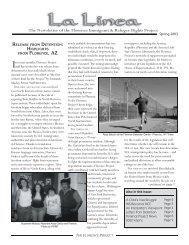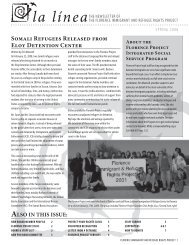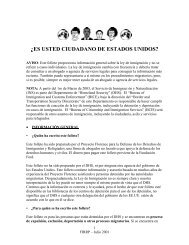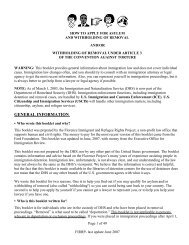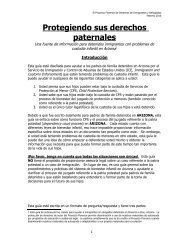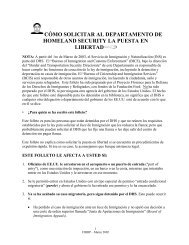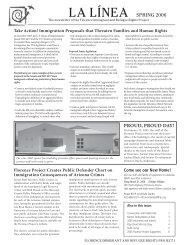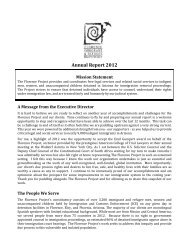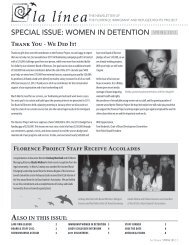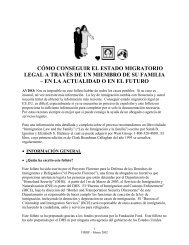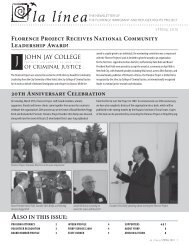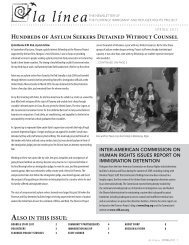quick reference chart and annotations for determining immigration ...
quick reference chart and annotations for determining immigration ...
quick reference chart and annotations for determining immigration ...
Create successful ePaper yourself
Turn your PDF publications into a flip-book with our unique Google optimized e-Paper software.
Immigrant Legal Resource Center, Florence Immigrant <strong>and</strong> Refugee Rights Project,<br />
Maricopa County Public Defender August 2012<br />
Aggravated Felony: This is not an aggravated felony as a crime of violence even with a<br />
sentence imposed of a year or more. But as always, where possible counsel should obtain a sentence of<br />
less than 365 days, in case there are future legislative changes. One recent proposal in Congress was <strong>for</strong><br />
manslaughter to be legislatively classed as a crime of violence, <strong>and</strong> thus an aggravated felony, if a year’s<br />
sentence was imposed.<br />
An offense that involves only negligence or even negligence amounting to reckless causation of<br />
injury will not be held a crime of violence within 18 USC § 16, <strong>and</strong> thus will not be an aggravated felony<br />
under 8 USC §1101(a)(43)(F) even if a sentence of a year or more is imposed. Leocal v Ashcroft, 125<br />
S.Ct. 377 (2004) (negligent DUI is not a crime of violence because does not create risk that <strong>for</strong>ce will be<br />
used, just that injury will occur); Lara-Cazares v Gonzalez, 408 F.3d 1217 (9th Cir. 2004) (killing a<br />
person by DUI with gross negligence, amounting to recklessness, is not a crime of violence because it<br />
does not create a risk that <strong>for</strong>ce will be used, under Leocal); Fern<strong>and</strong>ez-Ruiz v. Gonzales, 466 F.3d 1121<br />
(9th Cir. 2006) (en banc) (recklessly causing physical injury to another does not meet the federal<br />
definition of a “crime of violence” under 18 U.S.C. § 16). See further discussion at ARS § 13-1203,<br />
assault.<br />
The BIA has held that a death that is caused by “extreme recklessness or a malignant heart”—<br />
such as vehicular homicide while under the influence—may meet the aggravated felony definition of<br />
murder. Matter of M-W, 25 I&N Dec. 748 (BIA 2012). But because this statute requires a mens rea of<br />
negligence, rather than extreme recklessness, it should not be an aggravated felony <strong>for</strong> murder under 8<br />
USC § 1101(A)(43)(A).<br />
Other Grounds: As long as this is not a crime of violence, even if the record establishes that the<br />
defendant <strong>and</strong> victim had a domestic relationship this should not be a “crime of domestic violence” <strong>and</strong><br />
should not cause deportability under the domestic violence ground. See Note: Domestic Violence.<br />
However, if the record of conviction shows that the victim was a minor, it likely will be charged as<br />
deportable as a crime of child abuse, neglect, or ab<strong>and</strong>onment. Matter of Velazquez-Herrera, 24 I&N<br />
Dec. 503 (BIA 2008). Immigration counsel would have arguments against this if the age of the victim was<br />
not “actually required” in order to convict the defendant of the offense. United States v. Aguila-Montes<br />
de Oca, 655 F.3d 915, 937 (9th Cir. 2011) (en banc).<br />
. Manslaughter, A.R.S. § 13-1103<br />
A person commits manslaughter by:<br />
1. Recklessly causing the death of another person; or<br />
2. Committing second degree murder as defined in section 13-1104, subsection A upon a sudden quarrel<br />
or heat of passion resulting from adequate provocation by the victim; or<br />
3. Intentionally aiding another to commit suicide; or<br />
4. Committing second degree murder as defined in section 13-1104, subsection A, paragraph 3, while<br />
being coerced to do so by the use or threatened immediate use of unlawful deadly physical <strong>for</strong>ce upon<br />
such person or a third person which a reasonable person in his situation would have been unable to resist;<br />
or<br />
5. Knowingly or recklessly causing the death of an unborn child by any physical injury to the mother.<br />
Summary: While a plea to Negligent Homicide A.R.S. § 13-1102 is safer, this statute contains<br />
several subsections that may not be categorically removable. Defense counsel should avoid subsection<br />
(2) <strong>and</strong> generally plead to the straight statutory language of the offense.<br />
Arizona Criminal Chart with Explanatory Endnote – August 2012<br />
17



